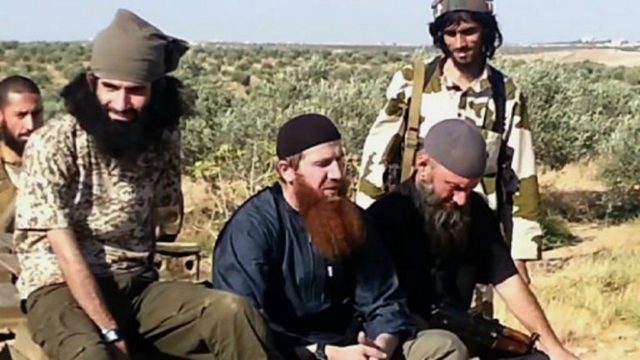
The Chechens Fighting for the Islamic State in Mosul
Publication: Eurasia Daily Monitor Volume: 13 Issue: 196
By:

Analysts who have followed developments in Syria and Iraq have increasingly paid attention to the presence of Chechen fighters in the area since 2013. An influx of large numbers of Chechen militants to Syria created conditions for the appearance of ethnicity-based Chechen armed groups.
Over time, individuals from the former Soviet Union republics joined groups founded by Chechen militants. Thus, gradually, the ethnicity-based armed groups that were indicated by a common name—Shishani (Chechens in Arabic)—also became known as Russian-speaking groups.
Within two to three years, Chechen combatants in Syria managed to create for themselves an image of seasoned fighters who had gone through the Chechen-Russian wars (VOA, September 29). In reality, only a handful of the Chechen militants in Syria actually possessed previous fighting experience in the Russian North Caucasus. The majority of the Chechen fighters in the Middle East were former students in Islamic institutions and refugees from Chechnya who settled in various Middle Eastern countries. Former Chechen fighters, who left Chechnya to receive medical treatment abroad after being wounded, comprised a small proportion of the militants in the Middle East.
The fact that Umar Shishani (Tarkhan Batirashvili) became one of the leading military figures in the Islamic State (IS) indicated that the Chechen corps had a disproportionately large sway among IS members, given their small overall number in the Middle East (Kavkazsky Uzel, July 15).
Chechen mercenaries today are fighting in the area of Aleppo in Syria under the command of Salahaudin Shishani (Peizulla Margoshvili), Muslim Shishani (Murad Margoshvili), and others. These groups have been based in Syria since 2013 and never made incursions into Iraq (Kavpolit.com, July 14, 2014).
Groups of Chechens also exist among the supporters of IS fighting in both Iraq and Syria. A rebel source said that the Chechens suffered large casualties in the first week of December during the siege of Mosul in Iraq. According to the source, his group is made up of several dozen Chechens, about the same number of Dagestanis, and a hundred other Russian-speakers from various republics of the former Soviet Union (Author’s interview, November 30).
The source among the insurgents, who identified himself as amir Abdullah Shishani, said that fighting continues in different parts of Mosul now and the IS command dispatches them from one part of the city to the other. The insurgent said that his group is unhappy about having to move around, while the Arab groups are allowed to stay in the same area. The Chechens reportedly have to change positions every day to help the Arab armed groups that keep retreating.
The leadership of IS closely watches individuals who transmit information to the outside world, including any contacts over the Internet with relatives. The IS security services crack down hard on anyone, including the Chechens, spotted transmitting information from the area of the fighting. According to the source, there were cases of Chechens being executed for making Skype calls and talking about the situation in Mosul. The locals also do not support the Chechen militants, according to the source in Mosul, although they do not express their hatred for them.
Amir Abdullah Shishani could not answer the question about the number of Chechens in Iraq. But according to his information, based on the situation in his group and other groups of Chechen militants, their total figure is declining. He said he received information that the Chechens suffered large casualties at the end of November, when several dozen were killed in one suburb of Mosul. The group of armed Chechens was relocating from one area to another when a US missile reportedly struck them.
After the death of Umar Shishani, many Chechens began abandoning the Islamic State, leaving Syria and Iraq, and moving to Turkey under various pretexts (Current Time TV, July 14). Some Chechen militants went back to their former Chechen commanders in Syria that they left in 2015 to join the IS and Umar Shishani. It appears, however, that few individuals are actually returning to Syria. Most Chechens are trying to leave Iraq and Syria altogether. Umar Shishani’s death indicated that he was actually one of the main figures in IS rather than being the front man for his older brother, as some analysts had asserted.
Those Chechen groups that continue fighting are likely to fight to the end, since they have no place to retreat to. Not everyone can afford to move to Turkey or an Arab country. It is even harder for them to return to Russia.
Views among the Chechen fighters have changed substantially in the past months in light of recent events in Syria and Iraq. Massive Islamist propaganda that targeted young Chechens and called on them to contribute to building the Islamic State does not exist anymore. Multiple channels for transporting Muslim volunteers to the Middle East via Turkey have either ceased to exist or at least do not operate as openly as they did at the start of 2016. Also, the Chechens themselves are now much less eager to go to the Middle East. Many Chechens continue to believe that the Syrian people must overthrow Bashar al-Assad, but they do not want to participate in the process themselves. Information from rebel sources in Mosul suggests that the positions of the few remaining Chechens are still quite strong; though it is unclear for how much longer they will last there.



